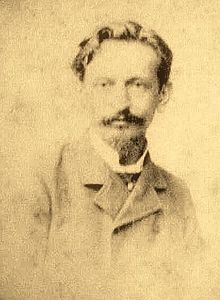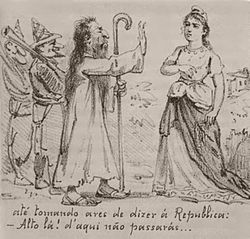Angelo Agostini
Angelo Agostini (* 1843 in Vercelli , † January 28, 1910 in Rio de Janeiro ) was a draftsman of Italian origin who became the first Brazilian cartoonist and journalist to become the most important graphic artist of the Second Empire. His career began in 1864 with the outbreak of fighting in the Paraguayan War and lasted more than 40 years. His last work is testimony to the overthrow of the republic and the consolidation of the oligarchy .
Life
Childhood and youth
Angelo Agostini was born in the northern Italian province of Piedmont and came to Paris as a toddler . In 1858 he began studying drawing and the following year, at the age of 16, accompanied his mother, the opera singer Raquel Agostini, on a tour to Brazil. They stayed in São Paulo from 1860 , where the young Italian began to work as a draftsman.
São Paulo
Four years later he founded the liberal weekly newspaper O Diabo Coxo (Lame Devil) with the lawyer, journalist and poet Luís Gonzaga Pinto da Gama and Sizenando Barreto Nabuco de Araújo (1842-1892 ). 1864 is also considered to be the beginning of his career as a cartoonist . In addition to Agostini's drawings, the low-cost Sunday paper O Diabo Coxo mainly published Gama’s texts on the abolition of the death penalty as well as news and critical articles by Barreto Nabuco de Araújo. The magazine received a lot of attention, but lived only briefly (1864-1865) despite its success.
In 1866 Agostini founded the weekly magazine O Cabrião (The Plague) with Américo de Campos and Antônio Manuel Reis and worked as editor. In the Cabrião he published satires on the Paraguay War and consistently targeted the clergy and the established colored elite of Sao Paulo on the front page. The magazine was well received by the public during its two-year publication period, but had to be discontinued in 1867.
A number of small articles should also be highlighted, such as Instruções Secretas dos Padres da Companhia de Jezus (Secret Instructions of the Brothers of the Society of Jesus = Jesuits), in which Agostini satirized the strategies of the religious order for enrichment and the caricature O Cemitério da Consolação em Dia de Finados , a satire on the Christian holiday. This cartoon caused heated polemics in two other magazines, the O Diário de São Paulo and the Correio Paulistano, and ultimately led to the Cabrião being sued as the first Brazilian publication.
At that time Agostini continued to develop his drawing style. In contrast to other comic artists, he did not tend towards easy, entertaining caricatures, but preferred a heavier intellectual approach with intentional changes.
Rio de Janeiro
The artist moved to Rio de Janeiro in 1867/1868 and worked for the magazines O Arlequim (Harlequin) from 1867 and Vida Fluminense (Life outside the city of Rio) from 1868 . He continued his intensive activities for the abolition of slavery, including several satirical depictions of Emperor Pedro II of Brazil .
Agostini brought together texts and images and, according to his conventions, created the first Brazilian picture stories under the title As Aventuras de Nhớ-Quim & Zé Caipora (The Adventures of Nhô-Quim and Zé Caipora). These stories were published in the magazines Vida Fluminense , O Malho and Dom Quixote . They were about two farmers who had recently arrived in the city and who both lived in a world that revolved around the imperial court and the mythology of rural Brazil. The children's story As Aventuras de Nhô Quim ou Impressões de Uma Viagem à Corte (The Adventures of Nhô Quim or Impressions of a Journey to the Court), published in the January 30th 1869 edition of Vida Fluminense, is considered to be the first ever comic strip in Brazil and one of the oldest in the world.
From 1869 to 1875 he worked on the magazine O Mosquito (Mosquito), in which he published a satirical caricature of the painting Passage de Humaitá [Passage of Humaitá] (1868) by Victor Meirelles (1832-1903) in 1872 .
Revista Illustrada
In January 1876 Angelo Agostini founded the Revista Illustrada , a committed opinion-forming journalistic medium in what was then Brazil. In the Revista in 1883, Agostini created the figure Zé Caipora and also used it in O Malho and later in Don Quixote . She was republished in sections in 1886, making her the first consistent Brazilian comic book character.
Abigail de Andrade
In 1888, shortly after receiving his Brazilian citizenship, the already married artist got caught up in a relationship with his art student Abigail de Andrade (1864– around 1890) from Vassouras in the province of Rio de Janeiro . Abigail was a promising artist at the time who was highly praised by critics and was the only woman to receive a gold medal in 1884 for her work on display at the Salon Imperial.
The illegitimate relationship, the pregnancy and finally the birth of their daughter Angelina in 1888 caused a scandal in Rio. Agostini had to resign from his editorial work for the Revista Ilustrada . The couple gave way to public pressure in October of that year, leaving Brazil and moving to Paris. In France, Agostini met new strokes of fate: in April 1890, his second child, son Angelo, died in April 1890 and his mother Abigail soon afterwards. Angelo Agostini returned to Rio de Janeiro, accompanied by his daughter Angelina Agostini , who later became a painter and died in 1973 at an old age.
Back in Brazil
After his return to Brazil, Agostini founded the magazine Don Quijote (1895-1906) and worked for the magazine O Tico Tico , which published the picture stories of his cartoon character Zé Caipora until December 1906. He also worked for O Malho and Gazeta de Notícias , among others .
From 1890 on he took part in exhibitions more often as an artist, from 1901 until his death even in all Exposições Gerais de Belas Artes (General Exhibitions of Fine Arts). When Agostini died in 1910, he had matured to become the greatest and most influential comic artist of the Second Empire (1840–1889) and more important than other well-known artists such as Pereira Neto and Hilarião Teixeira.
memory
The artist's name remains alive in the Prêmio Angelo Agostini (Angelo Agostini Prize), which is awarded annually in eight categories by the Association of Cartoonists and Caricaturists of São Paulo .
literature
- Laudelino Freire :. To século de pintura. Apontamentos para a história da pintura no Brasil, de 1816-1916. Fontana, Rio de Janeiro 1983.
- Carlos Roberto Maciel Levy: Exposições gerais de Belas Artes : catálogo de artistas e obras 1840-1933. s. l .: ArteData, 1990. 1 CD-ROM.
Web links
- DezenoveVinte: Angelo Agostini in Arte Brasileira do Século XIX e início do XX Portuguese
- Instituto Itaú Cultural: Angelo Agostini. In: org.br. Enciclopédia Itaú Cultural (Brazilian Portuguese).
- Worney Almeida de Souza: Angelo Agostini on Bigorna.net Portuguese
Individual evidence
- ↑ a b c d e f g h i j k Instituto Itaú Cultural: Angelo Agostini. In: org.br. Enciclopédia Itaú Cultural, accessed March 25, 2020 (Brazilian Portuguese).
- ↑ see brief description in the Open library
- ↑ see web link DezenoveVinte
| personal data | |
|---|---|
| SURNAME | Agostini, Angelo |
| BRIEF DESCRIPTION | Brazilian cartoonist, journalist and editor |
| DATE OF BIRTH | 1843 |
| PLACE OF BIRTH | Vercelli , Italy |
| DATE OF DEATH | January 28, 1910 |
| Place of death | Rio de Janeiro , Brazil |

